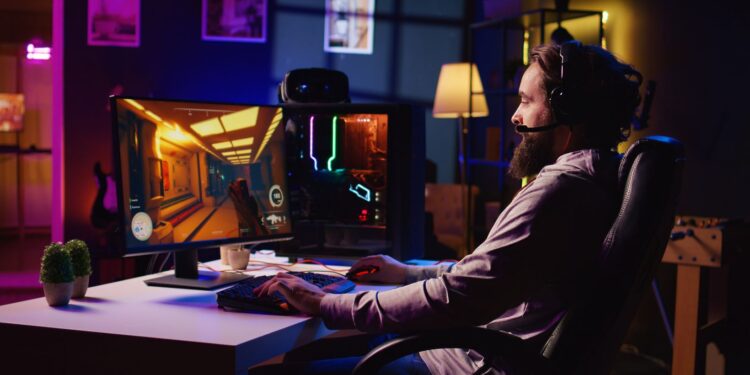When you launch a new game, it’s often the visuals that grab your attention first. Flashy effects, crisp animations, and bold colors can make even the simplest concept feel exciting. This kind of design adds depth, atmosphere, and immersion for some genres. But in others, too much flash can actually get in the way of the fun.
Genres Where Fancy Design Works Great
Some games just wouldn’t be the same without that visual wow factor. Here are a few where fancy design really pays off.
Online Slot Games
If you enjoy online slots, you’ve probably noticed how important visual style is. Games like Lucky Lady’s Charm Deluxe at LuckyBlock use glowing animations, smooth transitions, and bright symbols to make gameplay more engaging. It’s not just about looking good—these visuals help hold your attention, add excitement, and make the overall experience feel more rewarding.
Still, not every type of game benefits from a shiny presentation. Some games do better when they keep things clean and simple. It all depends on what kind of experience you’re looking for.
Action RPGs and Open-World Adventures
If you’ve played titles like Elden Ring, Final Fantasy XVI, or Horizon Forbidden West, you know how much the visuals matter. These games pull you into massive worlds with detailed environments, dramatic lighting, and intense effects. Every spell, sword swing, or boss battle feels more powerful when it’s paired with high-end design.
Fighting Games
In games like Street Fighter 6 or Mortal Kombat 1, flashy animations aren’t just for show—they help you feel the impact of every punch and combo.

The vibrant effects and exaggerated movements add energy to the fight, making every match feel like a mini-action movie.
Mobile and Gacha Games
If you’re into mobile games like Genshin Impact or Honkai: Star Rail, you’ve already seen how important visuals are. These games rely on sharp character designs, smooth animations, and sleek menus to keep you coming back. The better it looks, the more likely you are to stay hooked.
When Simpler Is Better
On the other hand, some genres benefit from visual simplicity. Here, fancy effects might slow you down—or worse, get in the way.
Competitive Shooters and MOBAs
In games like Valorant, Counter-Strike 2, or League of Legends, a flashy design can actually hurt your performance. You need to see clearly, react fast, and focus on your target. Too many visual effects can clutter the screen and throw you off. Clean design keeps you in control.
Puzzle, Platformer, and Indie Games
Games like Celeste, Undertale, and Baba Is You prove that simple visuals can still deliver powerful gameplay. These titles keep things minimal so you can concentrate on the puzzles or story. The art may be basic, but the experience stays sharp and meaningful.
Strategy and Simulation Games
If you’ve played RimWorld or Factorio, you know that it’s not about how the game looks—it’s about how it works. These games keep the graphics functional so you can focus on the systems and strategy. Adding too much flash might just make things harder to understand.
What You Get from Fancy Design
When it’s done right, high-end design adds a lot to your experience:
- Immersion: Fancy graphics help pull you deeper into the game world.
- Excitement: Explosions, lighting, and particle effects can make every action feel bigger.
- Visual Identity: A great art style makes a game stand out. Think of Persona 5’s menus or Cuphead’s vintage animation—you won’t forget that stuff.
The Downsides of Going Overboard
Not every game needs to be flashy. Here’s where fancy design can backfire:

- Performance Issues: If your system isn’t powerful enough, those high-end visuals can cause lags or crashes.
- Too Much Noise: Bright lights and busy effects can make it harder to focus, especially in competitive games.
- Style Over Substance: Sometimes a game looks amazing but doesn’t offer much beyond that. You might get bored once the wow factor wears off.
Striking the Right Balance
The best games know when to go big and when to hold back. Hades delivers fast-paced action with polished visuals, but nothing on screen feels overwhelming. God of War Ragnarök looks stunning, yet the design choices never pull you away from the story or combat.
Even indie games strike a nice balance. Hollow Knight, for example, keeps its art style simple yet polished, which adds to the game’s mood and flow. It proves you don’t need a huge budget to create something visually special, you just need to know what works for your game.
Conclusion
As a player, you’ve probably seen both sides: games that blew you away with their design and others that kept things stripped-down but brilliant. Flashy visuals can take a good game to the next level, especially in genres that thrive on spectacle. But when you’re chasing high scores, solving puzzles, or managing complex systems, a clean and focused layout might be the better choice.
In the end, it’s about what you enjoy. Whether you love a screen full of explosions or prefer crisp, simple gameplay, great design is always about supporting the experience—not stealing the spotlight.














































































































